Contents
Before we get into the many soybean health benefits, let us learn more about this super legume. Those who have carefully studied the Japanese language have discovered that, surprisingly, no word refers to a “hot flash,” a vasomotor symptom characterized by sudden vasodilation with a sensation of heat commonly suffered by menopausal women. This is not because Japanese women do not experience menopause but simply because they pass this period of hormonal change without symptoms.
Soon, investigators found that Japanese and Chinese women, in addition to not experiencing menopausal problems, have a lower incidence of breast cancer. Besides, people in the Far East experienced better reproductive health and lower cholesterol. The explanation for this is not genetic or racial factors but lifestyle, specifically diet. As is well known, Far Eastern cultures derive the bulk of their protein not from meat but from legumes such as soy and, to a lesser degree, from fish.
Numerous studies confirm that soybean, which many Japanese, Chinese, and Koreans eat daily, is responsible for their better reproductive health and lower breast and prostate cancer levels. This fact coincides with one of modern epidemiology’s great truths: good health depends more on dietary habits than genetic or hereditary factors.
Soybeans are a staple food in China, where they have been cultivated for more than three millennia. Their use spread to Japan in the 7th century of the Christian era. They did not arrive in Europe until a thousand years later, in the seventeenth century. They were first cultivated in the United States in the nineteenth century. However, until well into the twentieth century, soybeans were used as human food in North America and Europe.
Currently, the United States produces half of the world’s soybeans. However, soy consumption is still low in the Western world. Fortunately, recent decades have brought discoveries highlighting the healing properties of this food. Consequently, it is receiving the attention it deserves, although three thousand years later.
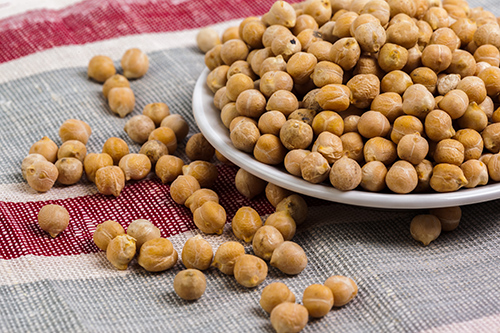
Soybean Nutritional Facts
The soybean is the most decadent natural food with vitamins, proteins, and minerals. It comprises beneficial phytochemicals, as well. Its remarkable capacity to sustain and thwart disease is better understood by reviewing its composition:
PROTEINS: Soybean is nature’s richest source of proteins. It contains 36.5 percent, meat with twenty percent, and eggs with 12.5 percent fall far behind. However, quantity is only part of the story. Soybean offers quality. Its proteins meet the body’s amino acid needs for adults and children. The only preventive recommendation is that soymilk or beverage destined for use in infant formulas be enriched with the essential amino acid methionine.
Commonly, legume proteins are lacking in the essential sulfurated amino acid methionine. However, soy protein contains enough of this vital amino acid to meet adult needs (but not those of nursing infants) and, thus, be considered complete. The biological value of soy protein is comparable to that of meat. Soy proteins supplement the natural quality of other vegetable proteins such as corn or wheat. When these grains are blended with soy flour, the result is a complete, high-quality protein. Because of this, soy flour is increasing to enrich bread and other baked goods. Experiments by the French National Institute of Agronomic Research show that soy proteins are digested and absorbed as quickly as cow’s milk. Soy proteins are slightly acidifying but less than meat.
FAT: In contrast to other legumes such as beans or lentils that contain less than one percent fat, soy can reach 19.9 percent, formed primarily of unsaturated fatty acids such as linolenic acid (fifty-five percent) and oleic acid (twenty-one percent). There is a small proportion of saturated fatty acids such as palmitic (nine percent), stearic (six percent), and other fatty acids (nine percent), among which is omega-3-type alpha-linolenic acid. Since soybean’s fatty acids are primarily unsaturated, soy fat helps reduce cholesterol levels.
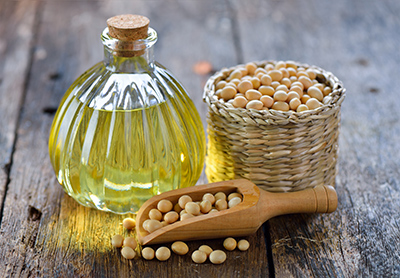
Soy oil, used in the human diet and the chemical industry, is derived from soy fats. Lecithin is a complex lipid that forms part of the fats in soy. Some exalt its medicinal properties, while others ignore them.
CARBOHYDRATES: These comprise 20.9 percent of soy’s weight and include a variety of oligosaccharides, saccharose, and a small amount of starch. In contrast to other legumes such as lentils, beans, mung beans, or adzuki, rich in starch, soy contains very little. Thus, it is well tolerated by people with diabetes.
VITAMINS: 100 grams of soy provide half of the daily necessities of vitamins B1 and B2 and twenty percent of the need for vitamins B6 and E. This surpasses all other legumes. However, in common with all legumes (except sprouts), soy is low in vitamin C and contains very little provitamin A.
MINERALS: Soy contains high amounts of minerals: One hundred grams provides 15.7 mg of iron, five times more than meat, and a sum that meets the daily need of an adult male for this mineral. Even though it is non-heme iron, which is more difficult to absorb than heme iron found in meat, the simultaneous presence of vitamin C in the intestine from fresh fruits and vegetables eaten in the same meal significantly increases the absorption of iron from soy.
Soy is also very rich in magnesium, phosphorous, and potassium: One hundred grams provide for most of the daily requirements of these minerals. It is also rich in calcium (277 mg/100 grams, more than double that of milk), meaning that 100 grams of soy provide more than a third of the daily requirement for this mineral. Alternatively, soy contains practically no sodium, which produces fluid retention in the tissues. This makes it very appropriate in cases of cardiovascular disease. Soy is also an amazing source of the trace elements zinc, copper, and manganese.
FIBER: Soy contains 9.3 percent fiber, most of which is soluble. This is significant because whole-wheat flour contains 12.2 percent fiber and bran 42.8 percent. However, products developed from soy comprise much less fiber (tofu, for example, has 1.2 percent). Soy fiber contributes to regularity in the digestive tract and lowers cholesterol levels.
NON-NUTRITIVE SUBSTANCES: Soybeans contain many chemical substances that are not nutrients in the world’s strict sense but are remarkably active within the body. Some of these, such as isoflavones, are considered phytochemicals. The discovery of these substances constitutes one of the most significant advances in nutrition science in recent years. These are the most noteworthy:
- Isoflavones: These constitute soy’s most important non-nutritive component and are responsible for most of its therapeutic properties. They are phytoestrogens (vegetable-based female hormones) with a similar effect to estrogen but without undesirable side effects. By linking with cellular estrogen receptor sites, isoflavones induce the beneficial effects of natural estrogen: an increase in bone mineralization, protection against arteriosclerosis, and a sense of well-being.
At the same time, isoflavones impede the primary drawback to the estrogen produced by the body, which is the permanent stimulation of the growth of breast and uterine cells. This physiological effect is necessary but becomes a cancer risk factor with time. Isoflavones’ simultaneous induction and blocking effects are described as partially agonistic/antagonistic agents on the estrogen receptors. They are also potent antioxidants.
Genistein (discovered in 1987) and daidzein are the essential soy isoflavones. Some researchers assert that soy products supply between 100 and 200 mg of isoflavones per 100 grams, while others view the amounts as somewhat less. Soy oil and soy-based baby formulas do not contain them. - Phytosterols: These substances are comparable to cholesterol but are from a vegetable source. They block cholesterol absorption in foods, thus reducing blood levels. It has been discovered that they also inhibit the development of cancer cells. Soy is one of the foods richest in phytosterols (161 mg/100 grams). The most abundant of these is beta-sitosterol.
Shown to prevent the growth of cancerous cells. They also reduce cholesterol levels by impeding its absorption in the intestine and increasing the fecal excretion of biliary acids, precursors to cholesterol.
As can be seen, soy is highly nutritious (it supplies 416 kcal/100 grams) and very rich in active ingredients that explain the following soybean health benefits:
Soybean Health Benefits
WOMEN DISORDERS: Eating soy and its byproducts helps women sustain hormonal balance thanks to its isoflavones (vegetable estrogens). The benefits obtained are the following:

- Regulation of the menstrual cycle, especially in pre-menopausal women
- Relief from menopausal symptoms: Regular intake of soy or its derivatives richest in isoflavones (soymilk or beverage, tofu, soy flour, protein extract) helps alleviate the conditions linked with menopause. This is the case with Japanese women, who do not require estrogen-based medicated skin patches, as do millions of Western women.
Of course, hormone replacement therapy based on estrogen eliminates the symptoms of menopause. It also helps avoid osteoporosis and lowers heart attack risk. However, it increases breast and uterine cancer risk by hormonal overstimulation caused by estrogen.
A soy-based diet and its derivatives represent a valid and effective estrogen hormone replacement therapy. It has the same beneficial effects on the bones and heart, with the great advantage of protecting against breast and uterine cancers.
Eating soy and its derivatives is recommended, not only for menopause but also as a hormone regulator whenever there are imbalances, whether for deficient or excess estrogen. - Reduced breast cancer risks: Studies at the University of Southern California clearly show that the more tofu a woman eats, the lower her risk of breast cancer. The protective effect of tofu is noted in both pre and post-menopausal women. Tofu is the richest soy product in isoflavone-type phytoestrogens, followed by soymilk (beverage). These substances, which include genistein, act as cytostatics; in other words, they stop the in vitro development of cancerous breast cells.
It is even more fascinating to note that genistein and other isoflavones act in vivo, within the human body, in the same way they do in vitro or in the laboratory. When they are present in the bloodstream in a concentration similar to that used in the laboratory, they are equally effective in halting the growth of cancerous cells.
Although, on the other hand, the situation within the human body is much more complex than in isolated cell culture in a laboratory, there is enough of a scientific base to recommend daily soy consumption (particularly tofu and soy beverage) for women with breast cancer or those who have suffered with this disease, and, of course, all who wish to prevent it.
MEN’S DISORDERS: Curiously, soy’s phytoestrogens induce the beneficial effects of natural estrogen but without the side effects. This is the case for women and men. Men who frequently eat soy enjoy the following soybean health benefits:

- Reduced risk of prostate cancer. Japanese men have a lower death rate due to prostate cancer because of the consumption of soy products, particularly tofu. One of the treatments for this type of cancer is the administration of estrogens, which are accompanied by undesirable feminizing effects in men. In contrast, soy phytoestrogens (isoflavones) protect against prostate cancer without any feminizing effect.
- Lowered risk of heart attack: Phytoestrogens, and those produced within the body, prevent arteriosclerosis and improve the health of the heart and arteries. Experiments on male monkeys show that regular consumption of phytoestrogen-rich soy products has no undesirable effects on the male reproductive system.
ELEVATED CHOLESTEROL: That regular consumption of soy and its derivatives reduces total blood cholesterol levels is a fact. The famed New England Journal of Medicine published a meta-analysis (scientific summary) in 1995 that reviewed the 38 most important clinical studies conducted up to that date to survey the effect of soy protein consumption on cholesterol. Various soy components contribute to its impact on cholesterol:
- Soy protein alone can reduce cholesterol when substituted for animal proteins. This seems related to the slight differences in the proportions of amino acids between animal and vegetable proteins. Various studies confirm this finding:
Men with high cholesterol, who substituted a portion of animal-baed protein with soy products, receiving fifty percent of their proteins from soy for a month, achieved a twelve percent reduction in cholesterol level. This represents a twenty-five percent reduction in heart attack risk.
Children with familial hypercholesterolemia (hereditary high cholesterol level) who drink soy milk significantly reduce cholesterol and triglycerides more than nonfat milk. - Isoflavones (phytoestrogens), like natural estrogen, reduce LDL cholesterol levels (which are harmful) and increase HDL cholesterol levels (which are beneficial).
- Saponins from soy, one of its non-nutritive components, prevent cholesterol absorption from foods in the intestine.
- Fiber and other non-nutritive substances in soy, such as phytic acid or protease inhibitors, also reduce cholesterol.

ARTERIOSCLEROSIS: Animal studies have shown that after six or more months of a soy protein diet that has been substituted for one based on animal protein, such as milk casein, there is an improvement in arteriosclerotic lesions. Soy’s anti-atheromatous action (preventing the formation of atheromas or rigid, narrow areas within the arteries) is due to two principal factors:
- Reduction in cholesterol level, which is the substance that is first deposited on arterial walls (calcium salts follow this).
- The direct action of soy isoflavones protects and regenerates arterial walls damaged by arteriosclerosis.
Until now, it was thought that the hardening of the arteries was irreversible. However, soy’s effect has been found that the arteries become less rigid and narrow. This is good news for those with arteriosclerosis and its consequent reduction in blood flow to the coronary (heart attack, angina), cerebral, iliac, and other arteries.
THROMBOSIS: It has been demonstrated experimentally that soy genistein prevents the formation of thromboses (clots) in the arteries, inhibiting the formation of thrombin (the substance that initiates the coagulation process) and platelet stickiness. The formation of a thrombus or clot within an artery is the most severe consequence of arteriosclerosis. Thrombosis of the coronary arteries leads to a heart attack. Thrombosis in the cerebral arteries results in stroke. Regular soy consumption benefits all those with “thick” blood, with the tendency to form thrombi or clots within the arteries.
OSTEOPOROSIS: Heavy use of animal-based proteins provokes calcium loss through the urine and is considered a primary contributing factor to osteoporosis in developed countries. On the other hand, soy proteins reduce the urinary loss of calcium and increase mineralization and bone density. This effect is particularly pronounced in menopausal women. The estrogenic effect of soy’s isoflavones also contributes to this.
KIDNEY FAILURE: Soy proteins do not interfere with kidney function, in contrast to the effect of animal proteins. Substituting soy products for meat benefits kidney function in the case of failure and nephrosis (degeneration of kidney tissue causing protein loss through the urine).

INFANT DIET: Soy provides high-quality protein for children that can adequately meet their nutritional and developmental needs. In cases where soy-based infant formulas are used exclusively (because of intolerance to milk), the amino acid methionine is usually added as a supplement. Soymilk (beverage), tofu, soy flour, and soy protein are suitable for children because of their ease of digestion and nutritional value. Additionally, there are three specific soybean health benefits for infant diets:
- Persistent diarrhea accompanied by malabsorption and malnutrition: A diet based on soymilk gives better results than a traditional diet of rice and yogurt, according to a study conducted in Pakistan.
- Lactose intolerance: A congenital deficiency of lactase (the enzyme that digests lactose or milk sugar) made feeding these infants exceedingly difficult until recent decades and the advent of soymilk.
- Childhood allergies: A soy-based diet cures many cases of skin eruptions, atopic dermatitis, asthma, and other childhood allergic reactions. The results of exchanging cow’s milk for soymilk (beverage) are surprising.
CANCER PREVENTION: The National Cancer Institute of the United States is dedicating much attention to the anticarcinogenic effects of soy and its derivatives. A constant stream of animal studies and human statistics confirm that soy and its products halt the growth of cancerous cells. The effect is seen in both hormone-dependent tumors and those that are not.
Studies in Japan show that daily consumption of soy products reduces the risk of breast, colon, rectal, stomach, prostate, and lung cancers. In addition to prevention, soy may play a role in a cure that has still not been sufficiently demonstrated. Nonetheless, there is an excellent base to include soy in the diet of those diagnosed with cancer. Without question, the next few years will bring discoveries about the anticarcinogenic powers of soy.
Soybean Scientific Facts
- Scientific name: Glycine max (L.) Merr.
- Scientific synonyms: Dolichos soja, L., Phaseolus max L., Soja hispida Moench.
- Other names: Soy.
- French: Soja.
- Spanish: Soja, soya.
- German: Soja.
- Description: Soybeans are the seeds of the soy plant, a herbaceous plant of the botanical family Leguminosae that grows to a height from half a meter to one meter. The spheroid seeds, or soybeans, are eight to ten mm long and grow within a pod-like pea.
- Environment: Soy is native to China and has been cultivated for millennia. Today, it grows in temperate regions on the five continents. The United States produces half of the world’s soy.

Soybean Cultivation
Soy is the most widely cultivated legume in the world, possibly because:
- It requires no fertilizers: Bacteria inhabit the roots of the soy plant, the same as those of other legumes, that directly convert nitrogen from the air into ammonia and nitrates, making fertilizer use unnecessary.
- They produce higher-quality protein in less time than any other plant. No other crop can have two thousand kg of seeds per hectare in less than four months, which equals seven hundred kilograms of protein.
Unfortunately, only a tiny portion of the world’s soy production is used to feed humans. Most are used as animal feed and as raw material for industry. World hunger could be conquered if all of the soy produced (about over one hundred million metric tons annually) was used for human consumption instead of raising animals for meat.
Green Soy and Adzuki
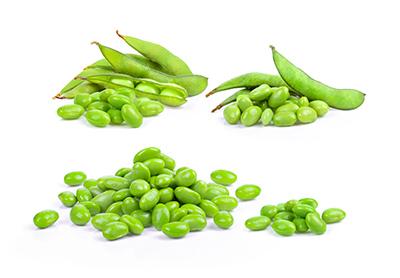
These two legumes are close to common soy regarding nutritional, dietary, and therapeutic value. However, they are more appropriate for regular healthy use because of their softer texture and better flavor. Both belong to the genus Vigna, whereas common soy belongs to Glycine. Green soy and adzuki are characterized by high-quality proteins, although in a lower proportion than common soy.
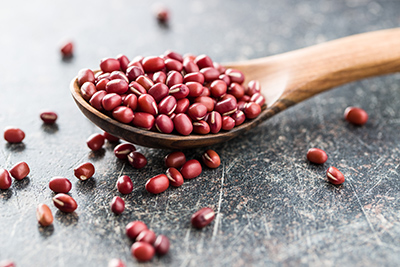
They are also remarkable for their richness in vitamins B1, B2, B6, calcium, phosphorus, magnesium, and iron, although always somewhat less than common soy. These legumes also contain phytoestrogens (isoflavones) and share soy’s hormonal-regulating, cholesterol-reducing, and cancer-preventing properties.
Green soy and adzuki contain fewer proteins, less fat, and more carbohydrates than common soy.
GREEN SOY (Vigna radiata [L.] Wilczek): The so-called green soy or mung bean is originally from India and is gaining fame because of its pleasant taste and digestibility. As with all legumes, it is boiled after it has been soaked (cooking time: approximately forty-five minutes). It may also be eaten as sprouts.
ADZUKI (Vigna angularis [wild.] Ohwi et Ohashi): Adzuki is also appropriately cooked, although it requires a more prolonged cooking time than green soy (50 to 60 minutes). It is also very nutritious and tasty.
Effect of Soy Protein Consumption on Blood Lipid Levels
It has been proven that daily consumption of 30 to 50 grams of soy protein (for example, two glasses of soy beverage and a soy-based burger), substituted for an equal amount of animal-based protein, produces the following soybean health benefits:
- 9.3 percent reduction in total cholesterol.
- 12.9 percent reduction in LDL cholesterol (harmful).
- 2.4 percent increase in HDL cholesterol (beneficial).
- 10.5 percent reduction in triglycerides.
Soy’s effect is remarkable in individuals with elevated cholesterol levels (over 230 mg/100 ml = 6 mMoles/liter).
How to Use and Prepare Soybean
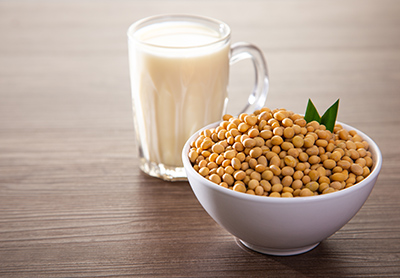
- COOKED SOYBEANS: These beans must be soaked for several hours and boiled for sixty to ninety minutes, preparing them like any other legume. Their flavor is somewhat unique and not necessarily to everyone’s taste. Mung beans, green soy, and adzuki are more appropriate than ordinary soybeans for cooking.
- FLOUR: This is available in two types: defatted (fifty percent protein) and whole (forty percent protein). When mixed with wheat flour, either type increases nutritional value and produces a very suitable dough for various bakery applications without adding eggs (soy lecithin acts as an emulsifier, just as lecithin in eggs). Many delicious vegetarian dishes may be based on soy flour.
- SOY PROTEIN: This is available in various forms (concentrated, isolated, or texturized). Its protein concentration ranges from seventy percent to ninety-six percent. It is particularly suited to preparing meatless dishes.
- SOYMILK: Also known as soy beverage, soy milk is a substitute for cow’s milk, but it contains less calcium and no vitamin B12.
DISCLAIMER: All content on this website is presented solely for educational and informational objectives. Do not rely on the information provided as a replacement for advice, diagnosis, or treatment from a qualified medical expert. If you are pregnant, nursing, or have any preexisting medical concerns, talk to your doctor before using any herbal or natural medicines.
REFERENCES
- George D. Pamplona-Roger, M.D. “Encyclopedia of Foods and Their Healing Power.” George D. Pamplona-Roger, M.D. Encyclopedia of Foods and Their Healing Power. Trans. Annette Melgosa. Vol. 2. Chai Wan: Editorial Safeliz, 2005. 264, 265, 266, 267, 268, 269, 270, 271. Print. [Soybean health benefits]
- Taku K, Melby MK, Kronenberg F, Kurzer MS, Messina M. Extracted or synthesized soybean isoflavones reduce menopausal hot flash frequency and severity: systematic review and meta-analysis of randomized controlled trials. Menopause. 2012 Jul;19(7):776-90. doi: 10.1097/gme.0b013e3182410112. PMID: 22534596.
- Reynolds K, Chin A, Lees KA, Nguyen A, Bujnowski D, He J. A meta-analysis of the effect of soy protein on blood lipids. Am J Cardiol. 2006 Jun 1;98(5):633-40. doi: 10.1016/j.amjcard.2006.01.047. PMID: 16860163.
- Wu AH, Ziegler RG, Horn-Ross PL, Nomura AM, West DW, Kolonel LN, Rosenthal JF, Hoover RN, Pike MC. Tofu and risk of breast cancer in Asian-Americans. Cancer Epidemiol Biomarkers Prev. 1996 Nov;5(11):901-6. PMID: 8942667.
- Yan L, Spitznagel EL. Soy consumption and prostate cancer risk in men: a revisit of a meta-analysis. Am J Clin Nutr. 2009 Apr;89(4):1155-63. doi: 10.3945/ajcn.2008.27121. Epub 2009 Feb 18. PMID: 19225128.
- Messina M. Soy and Health Update: Evaluation of the Clinical and Epidemiologic Literature. Nutrients. 2016 Nov 24;8(12):754. doi: 10.3390/nu8120754. PMID: 27898235; PMCID: PMC5188408.
- Hoffman JR, Falvo MJ. Protein – Which is Best? J Sports Sci Med. 2004 Sep 1;3(3):118-30. PMID: 24482589; PMCID: PMC3905294.
- U.S. Department of Agriculture, Agricultural Research Service. FoodData Central, 2019. fdc.nal.usda.gov.
- Li Z, Hong Q, Wu Y, Li Y, Li C, Liu S, Zhang X. Soy protein intake and body composition changes in overweight and obese adults: a systematic review and meta-analysis of randomized controlled trials. Eur J Nutr. 2020 Dec;59(8):3575-3589. doi: 10.1007/s00394-020-02205-9. Epub 2020 Mar 13. PMID: 32166223.
- Messina M, Redmond G. Effects of soy protein and soybean isoflavones on thyroid function in healthy adults and hypothyroid patients: a review of the relevant literature. Thyroid. 2006 Mar;16(3):249-58. doi: 10.1089/thy.2006.16.249. PMID: 16611048.
Last update on 2025-06-16 / Affiliate links / Images from Amazon Product Advertising API





